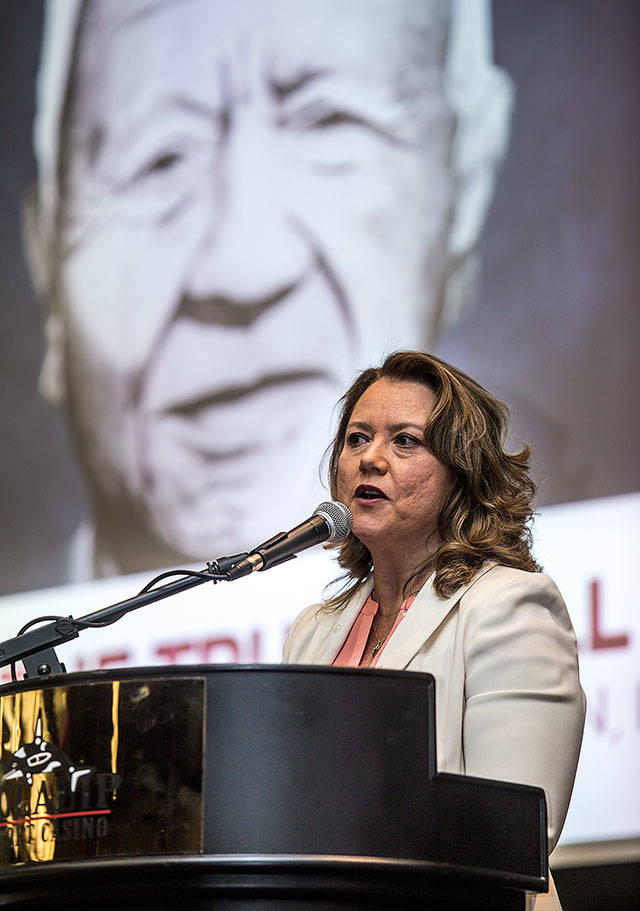The decision to close commercial fishing for Quinault River blueback (sockeye) salmon for conservation purposes this year is part of the ongoing effort by the Quinault Indian Nation to deal with the very tangible costs of climate change.
After announcing the blueback closure on the river last week for 2019, Quinault President Fawn Sharp traveled to Washington, D.C. with a message for Congress about how the entire Quinault ecosystem from the glacier to the ocean is being harmed by climate conditions that have major impacts, economically as well as environmentally.
“We are really trying to do some forecasting, not only for scientific purposes to build up the resilience of our stocks across the board, but also for our business,” Sharp said of the announcement. “The Quinault have always let science drive how we handle our fisheries, but it’s also a factor in how we build our business plans. That will have a direct impact on all those fishers, but we’re likely going to declare another fisheries disaster this season.”
Sharp was to testify before a congressional committee on Tuesday about climate change. She noted she took a helicopter ride this summer over the bare remains of the Anderson Glacier above the Quinault River and saw how a nearby glacier also is “nearly gone as well. And the few remaining have dramatically receded in the last eight years.”
“The impacts are going to become more frequent and more intense,” Sharp predicted.
The blueback closure was in response to a recent forecast by the Quinault Dept. of Fisheries for a second consecutive year of historically low return of wild adult salmon to spawn in the Quinault River. The 2019 forecast follows a year in which the third smallest return on record occurred: total return of spawning fish in 2018 of just 6,619 blueback salmon. Blueback runs are almost entirely made up of wild fish. Annual runs averaged nearly a quarter million fish until the 1950s.
Warm ocean temperatures seen in recent years, linked to climate change driven by burning fossil fuels, create “lean times for salmon as the productivity of their prey, like plankton and krill, falls,” according to a statement about the closure last week. “Marine conditions for blueback returning in 2019 have been, on average, among the poorest in the past two decades.”
Later this month, scientists are expected to complete a report that will show a 20-year trend of the tribe’s catch, with forecasting based on climate modeling. “That will then allow us to determine our predicted resource, and to what extent we can open the fisheries for individuals,” Sharp said.
It could determine everything to how many fish can be caught to how much Dungeness crab can be supplied to the Quinault Beach Resort, impacting the entire tribal economy and governmental funding. The blueback closure will financially affect more than 40 Quinault families who depend on blueback for supplemental income and will harm Quinault Nation business enterprises for the second year, a news release noted. “It has a multiplier impact to us,” Sharp said.
“The devastation of our iconic blueback salmon has struck at the core of what it means to be Quinault,”
Sharp said in prepared remarks before the closure was implemented. “This incalculable loss jeopardizes the cultural identity of our people and our ability to support and nourish our families. We will be stepping up efforts to hold big oil accountable for their environmental exploits, stop illegal poaching and looking at every other option to help displaced fishermen, including declaring a fishing disaster.”
Currently, the tribe is in the midst of the Upper Quinault River Restoration process with agency stakeholders such as the Olympic National Park, the Forest Service, neighboring counties and the state. A public meeting set for Tuesday on development of road and access solutions was cancelled because of weather. In the past, Sharp noted, the tribe has been consulted by other agencies on plans in the Upper Quinault only to see more projects that threaten fish habitat.
“Our goal right now is restoring that original spawning habitat,” Sharp said. “Our goal is the healthiest ecosystem possible. We want to make sure that future generations know and appreciate the upper Quinault the way our ancestors have and the way we have historically.”



